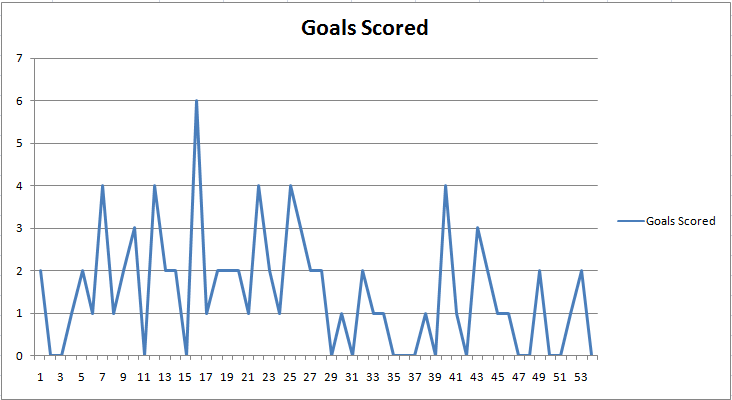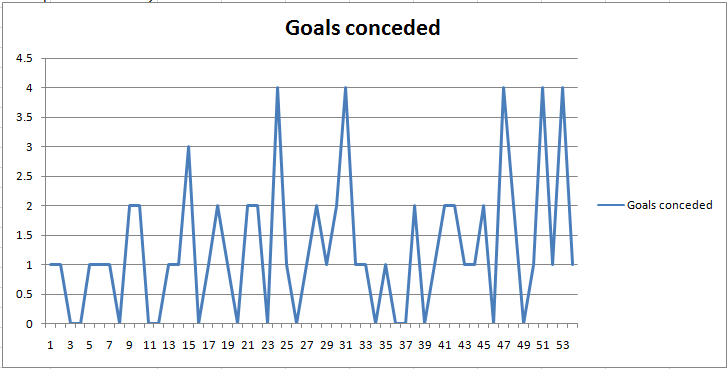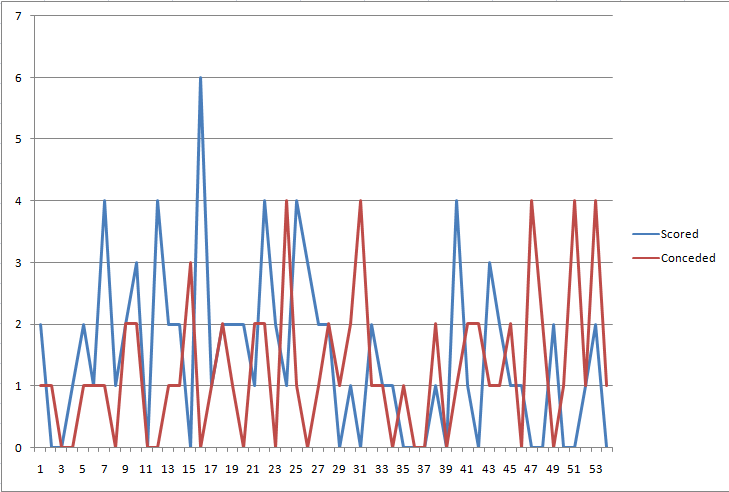This series will take a look at the last World Cup cycle from a more tactical/analytical perspective. How the team changed under the three managers, their different approaches to the game, and how they utilized the player pool. It will also take a statistical look at each manager and the overall results.
We’ll start with the numbers in part 1 and take a simple look at some basic statistics for the cycle. A detailed statistical analysis can’t be performed because, as far as I know, there isn’t a company or organization that keeps detailed (and archived) record of Korea’s match statistics (beyond the three World Cup ones).
Big Picture
[table “” not found /]
While we will take a closer look at each manager in more detail in subsequent posts, it’s worth taking stock of some of the “big picture” numbers. From a purely statistical view, Cho Kwang-Rae quite easily had the best results. His win percentage is the highest, his goals per game is the highest, and his goals conceded per game is the lowest. Now, there are of course, non-statistical things to consider when looking at Cho Kwang-Rae, but that will be discussed, again, later.
The other thing that catches the eye is the general decline of the team’s performances over the four year period. The win percentage steadily drops from Cho to Choi to Hong. And similarly, the average goals per game steadily decreases while the average goals conceded per game steadily increases.
Again, this is a point to be discussed in detail later, but I was struck a bit by one thing. Many people have excused Hong’s poor results due to the lack or time he had with the team. No one doubts that because it’s not possible. Cho Kwang-Rae was in charge for approximately 14 months. Choi Kang-Hee was in charge for approximately 18 months. Hong Myeong-Bo was only in charge for about 10 months. But, Hong was in charge of 19 matches, compared to Choi’s 14 matches. Granted for six of those matches, Hong had restricted squad options, but is the fact that Hong oversaw more matches in total relevant to how we view his teams’ performances? Food for thought for the Hong post.
Home Performance
[table “” not found /]
Cho Kwang-Rae again posts the most impressive results going 7-1-0 (the draw a 0-0 with Japan) with 20 scored and just 4 conceded. Choi Kang-Hee’s record is a respectable 6-0-2 (the two losses coming to Australia and Iran) with 15 scored and 7 conceded. Hong Myeong-Bo’s record is a more modest 3-3-4 with 11 scored and 10 conceded. Overall, the team boasted strong, but not incredible, numbers of 16-4-6 with 46 scored and 21 conceded.
Away Performance
[table “” not found /]
Korea was very hit or miss when playing away from home. Please note, for this category “away” means they are playing in the opposition’s country (like playing Japan in Japan). Away from home, Cho Kwang-Rae’s sides were much more average, going 2-2-3 with 5 scored and 7 conceded. Choi Kang-Hee went 1-2-1 with 7 scored and 5 conceded. Hong Myeong-Bo only played two official away games (to the USA and Greece), and went 1-0-1 with 2 scored (against Greece) and 2 conceded (against the US). Overall, the team was, as said earlier, hit or miss, going 4-4-5 with 14 scored and 14 conceded.
Neutral Venue Performance
[table “” not found /]
Finally, we come to the “neutral venue” performances. These are matches that were not played in Korea or the opposition’s country. So, they are mainly international tournaments (2011 Asian Cup and 2014 World Cup). Cho Kwang-Rae boasts an impressive 4-2-0 record with 13 scored and 7 conceded. Note, I am using betting rules results for this one. So, the semifinal result against Japan in the Asian Cup is being recorded as a 2-2 draw. Choi Kang-Hee has terrible results (although slightly understandable) with a record of 0-0-2 with 1 scored and 8 conceded against the Spanish (in Switzerland) and Croatia (in London). Hong Myeong-Bo doesn’t fare much better with a record of 1-1-5 with 5 scored and 16 conceded. It must be said though, that Cho Kwang-Rae faced slightly easier opposition than the other two. Cho faced largely smaller Asian nations in the Asian Cup, whereas Choi took on two big European teams in Europe and Hong was facing World Cup caliber teams around the world.
Combined “Away+Neutral” Performance
[table “” not found /]
If you want to look at Korea’s performances outside of Korea in total the numbers don’t change a whole lot. Cho Kwang-Rae puts up the best numbers going 6-4-3 with 18 scored and 14 conceded. But again it must be noted that some of those numbers come at the expense of weaker Asian teams like India and Bahrain. Choi Kang-Hee’s numbers are still decidedly average at 1-2-3 with 7 scored and 13 conceded. Hong Myeong-Bo’s number are still poor at 2-1-6 with 7 scored and 18 conceded.
Players Used
[table “” not found /]
Top 10 Appearances Overall (includes both starts and sub appearances)
[table “” not found /]
A more detailed list of the players used by each manager will be available in later posts where we look at each manager in depth. But, the one that jumps out here is Choi Kang-Hee. Choi oversaw, as mentioned earlier, the fewest number of games as national team manager, but he easily used more players than the other two did. Choi also has the fewest players that made a large number of appearances (at least 10) under his charge.
How you choose to look at those number depends on how you want to view Choi’s decisions. You can take a more positive spin and say that Choi was frequently trying to find the right blend of players, or a more negative spin and say that Choi didn’t know what he was (trying) to do. Whatever fits your narrative.
Unsurprisingly, Jung Sung-Ryong topped the list of appearances as he was the number 1 keeper for all three managers. Cho Kwang-Rae was the only manager who didn’t use another keeper in any match (save the cameo start for Lee Won-Jae after the World Cup). Choi Kang-Hee also used Ulsan’s Kim Young-Gwang for a few matches, while Hong used Kim Seung-Gyu (coincidentally Kim’s understudy at Ulsan).
Slightly surprisingly, Lee Keun-Ho and Ji Dong-Won come in at 2nd and 3rd on the list. Lee Keun-Ho featured prominently under Choi Kang-Hee and was a frequent player for Hong as well, although he mainly started in the restricted squad matches and was a sub when all players were available. Ji Dong-Won featured heavily under Cho Kwang-Rae and then in diminishing numbers under both Choi and Hong. Lee Jung-Soo and Hong Jeong-Ho are slight surprises in the top 10, with both getting virtually all their numbers under two of the three managers. Lee Jung-Soo was a regular under Cho Kwang-Rae and made a handful of appearances under Choi. Hong Jeong-Ho was of course a regular for Hong, but also made numerous appearances under Cho. Hong Jeong-Ho didn’t play at all under Choi Kang-Hee, but that was possibly due to injuries and his linkage to the K League match fixing scandal.
It’s important to remember that these numbers include both starts and sub appearances. Players like Ji Dong-Won and Son Heung-Min rank high on the list largely because of a high (relatively) number of sub appearances. Son made nine appearances under Cho Kwang-Rae and eight under Choi Kang-Hee, but virtually all are short cameos. Ji’s is similar when under the supervision of Choi and Hong Myeong-Bo. Compare that to the likes of Ki Sung-Yueng and Lee Chung-Yong whose 37 and 28 appearances are largely starts.
Scorers
[table “” not found /]
Top 10 Scorers Overall
[table “” not found /]
Three players top the scoring chart, and I don’t think any will be too surprising. Park Chu-Young’s scoring rate is statistically impressive, 11 in 22 games, but it’s worth noting that 10 of those goals came under Cho Kwang-Rae, with only one coming under the combined eras of Choi Kang-Hee and Hong Myeong-Bo. Koo Ja-Cheol’s goals are slightly more spread, but a majority (7) came under Cho. Lee Keun-Ho scored the bulk of his goals (5) under Choi Kang-Hee. Ji Dong-Won scored all eight of his goals under the guidance of Cho Kwang-Rae.
Perhaps the most disappointing thing about these numbers is that of the top 10 scorers, eight of them were in the World Cup squad. Only Lee Dong-Gook and Kim Chi-Woo did not make the trip to Brazil. Between the other eight, 51 goals were scored (54 minus the three World Cup goals). A respectable haul, and it makes the feeling and thoughts of a lack of goal scorers that much more depressing.
The above graph charts the goals scored (in each game) over the course of the last World Cup cycle. There isn’t too much “enlightening” info in it, but it does clearly show the split between Korea’s more successful first two years of the cycle, and the poorer second half.
Contrasted with this second chart which shows the goals conceded in each game. Korea always had problems keeping clean sheets, but there is a notable increase in how frequently Korea conceded two or more goals per game. Plus the obvious spike in conceding four (twice under Choi, three times under Hong).
This final chart simply combines the prior two charts into one. Again you can clearly see the changing fortunes of the national teams as the blue line (goals scored) eeks down, while the red line (goals conceded) creeps up. Which brings us to our final table.
1st 27 Games vs 2nd 27 Games
[table “” not found /]
We often use the cliche expression of “a tale of two halves” to describe games and how they change. But, it seems to be appropriate to describe Korea’s last World Cup cycle in total. The first 27 games, Korea was respectable and was, in part, probably what helped fuel the high expectations for the World Cup. The team went 18-5-4 with 54 scored and 26 conceded. Not too shabby. But the second 27 games was poor. The team only went 7-6-14 with 25 scored and 40 conceded. In percentage terms, the team won 66.67% of their games in the first half to only winning 25.93% of their games in the second half. Why that is, is the main discussion point of this series, and is what we will talk about in depth in the latter posts.



Very interesting stuff. Much appreciation jae!
Can any1 explain y exactly Cho was sacked? (Think it was a shocking upset loss to sum low ranked team? In which case that’s awfully knee jerk =/). Cuz those #’s r impressive What kind of manager was he, would u guys say, tactically/personnel, everything? Don’t wanna jump to “proof in pudding” conclusions, but… those results O.o
What kind of manager was he, would u guys say, tactically/personnel, everything? Don’t wanna jump to “proof in pudding” conclusions, but… those results O.o
P.S.: I can’t seem to access the “KNT search 4 a nu manager” post, its all like a blue screen & the comments section doesn’t even show up
Two losses to Japan and then Lebanon left Korea needing a result in their final game in Kuwait or else they wouldn’t qualify for the last round of AFC Qualifying. That’s why Hwangbo Kwan decided to let him go.
I understand why the decision was made but I wasn’t following Korea’s NT too much post WC so someone else is going to help you out on that.
As for the tecnical bug… weird. Try again, then if not working try clearing your cache. That always works. Always as in most of the time.
That was the officially given reason for his sacking, but most “insiders” say that it was political. Cho had ruffled some feathers at the KFA, and the losses to Japan, particularly the 3-0 loss in Japan, plus the Lebanon result gave him an excuse to can him.
Depending on circumstances, wonder if Cho could b persuaded to return? & would this b desirable?
Doubt it, even though Hwangbo Kwan wouldn’t be there, it would be a massive ego blow to KFA. Basically re-hiring a coach they decided wasn’t good enough.
YEah, that situation seems very unlikely. The KFA is too proud to do that.
A more detailed post on Cho KR will be coming next in the series, and it’ll talk about his tactics, player selection, etc in detail.
Looking 4ward 2 it!
Got that blue screen fixed – that was weird, some hidden coding turned everything blue…
Thx, can finally read it
PJY was a boss back in the vintage 2010-2011.
Ok, I might sound a bit like beating a dead horse, for which I sincerely apologize. However, I’m firmly of the belief that people actually just overrated the Korean squad and that coupled with the lack of player leadership resulted in the progressively, or rather, regressively poor showing. For instance, I was one who advocated PJY being on the squad simply because PJY was clearly better than the others even in poor form, which was not so much a credit to PJY, but a sad commentary on Korea’s lack of depth. All that to say, while I have preferences in terms of managers, I think what the stats Jae has shown us doesn’t reveal anything about the quality of the coaches, but rather the quality of our players. Maybe that’s a harsh statement, but it’s hard to look at it any other way when Korea’s regression didn’t begin with Choi or Hong, but with Cho. Now, if we want to say that all 3 are awful, sure I’ll listen to what you have to say, but I think the truth that most Korean fans are too afraid to admit is that fans of the KMNT had simply overrated the squad, simply because we had a record number of players in Europe, as if that inherently meant something, which it does not. It is surely a positive trend, if we can put it that way, that more players are getting chances in Europe, but it really doesn’t inherently mean much regarding quality. I mean, if you really think about it, only SHM and maybe KSY are A-List Euro Club team capable players. SHM isn’t really there yet, though I think he can get there, and I believe KSY has the talent but not the consistency. I would’ve included LCY four years ago as a possibility, but sadly, I think the injury really has robbed him of what made him special. All that to say, I appreciate the look at the coaches and the upcoming analyses, but I’m having serious doubts about assessing the brunt of the responsibility on the team’s failure on anyone, including the unlikable Choi, other than squarely on the players’ lack of quality.
You’re a little ahead of me, but whatever, mini-preview time. I’m breaking the review down by coach simply because it’s the easiest way to make the series neat and manageable. I’m still a long way from finishing my conclusions about the past four years (still trying to dig up old full matches from Cho and Choi’s tenures to review), but my initial conclusions/thoughts are similar to yours. I won’t use the term “overrated” yet, but it does strike me that over the period the squad was, in the end, just not good enough. And that’s not necessarily a fault of the manager(s). The stats are part of the picture, but not the whole picture. Ultimately for this series to make sense you need to look at all of it and not just a single piece.
yea, sorry for jumping ahead. i did say that i’m still looking forward to your analyses of the coaches. =)